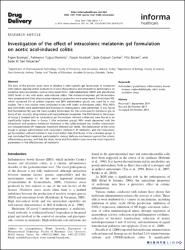| dc.contributor.author | Esiringu, Figen | |
| dc.contributor.author | Tugcu-DemirÖz, Fatmanur | |
| dc.contributor.author | Acartürk, Fusun | |
| dc.contributor.author | Cevher, Şule Coşkun | |
| dc.contributor.author | Bircan, Filiz | |
| dc.contributor.author | Sarı Kılıçaslan, Seda Mehtap | |
| dc.date.accessioned | 2019-10-19T17:26:56Z | |
| dc.date.available | 2019-10-19T17:26:56Z | |
| dc.date.issued | 2016 | |
| dc.identifier.issn | 1071-7544 | |
| dc.identifier.issn | 1521-0464 | |
| dc.identifier.uri | https://dx.doi.org/10.3109/10717544.2014.982773 | |
| dc.identifier.uri | https://hdl.handle.net/11421/14382 | |
| dc.description | WOS: 000386593400023 | en_US |
| dc.description | PubMed ID: 25547269 | en_US |
| dc.description.abstract | The aims of the present study were to develop a colon-specific gel formulation of melatonin with sodium alginate and to evaluate its in vitro characteristics and intracolonic performance on oxidative stress parameters, such as nitric oxide (NOx), malondialdehyde (MDA) and glutathione (GSH) levels in rats with acetic acid-induced colitis. The melatonin-alginate gel formulations were prepared and their physico-pharmaceutical properties were determined. Formulation M5, which contained 3% of sodium alginate and 20% polyethylene glycol, was used for in vivo studies. The in vivo studies were conducted in rats with acetic acid-induced colitis. NOx, MDA and GSH levels were determined and histological investigations were performed. It was found that formulation M5 was the most suitable formulation for the colon-specific melatonin gel, in terms of pH, viscosity, drug release and mucoadhesion properties. The MDA levels in the tissues of Group 2 (treated with an intracolonic gel formulation without melatonin) were found to be significantly higher than in Group 1 (the untreated group). NOx levels decreased with the intracolonic and systemic melatonin treatment in the colitis-induced rats. Neither intracolonic nor intra-peritoneal (IP) melatonin treatment affected GSH levels. The epitelization of the colon tissues in groups administered with intracolonic melatonin, IP melatonin, and the intracolonic gel formulation without melatonin was much better than that found in the untreated group. It was concluded that melatonin participated in various defense mechanisms against the colonic inflammatory process, and that the dose, route and formulation type were the most important parameters in the effectiveness of melatonin. | en_US |
| dc.description.sponsorship | Gazi University Research Foundation [BAP 02/2009-10] | en_US |
| dc.description.sponsorship | This study was supported by a research grant from Gazi University Research Foundation (BAP 02/2009-10). | en_US |
| dc.language.iso | eng | en_US |
| dc.publisher | Taylor & Francis LTD | en_US |
| dc.relation.isversionof | 10.3109/10717544.2014.982773 | en_US |
| dc.rights | info:eu-repo/semantics/openAccess | en_US |
| dc.subject | Antioxidant | en_US |
| dc.subject | Glutathione | en_US |
| dc.subject | Inflammatory Bowel Disease | en_US |
| dc.subject | Malondialdehyde | en_US |
| dc.subject | Nitric Oxide | en_US |
| dc.subject | Oxidative Stress | en_US |
| dc.title | Investigation of the effect of intracolonic melatonin gel formulation on acetic acid-induced colitis | en_US |
| dc.type | article | en_US |
| dc.relation.journal | Drug Delivery | en_US |
| dc.contributor.department | Anadolu Üniversitesi, Eğitim Fakültesi | en_US |
| dc.identifier.volume | 23 | en_US |
| dc.identifier.issue | 7 | en_US |
| dc.identifier.startpage | 2318 | en_US |
| dc.identifier.endpage | 2326 | en_US |
| dc.relation.publicationcategory | Makale - Uluslararası Hakemli Dergi - Kurum Öğretim Elemanı | en_US] |


















